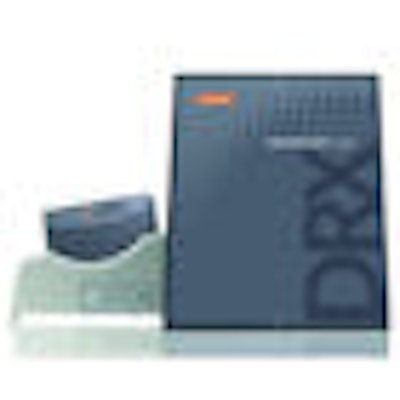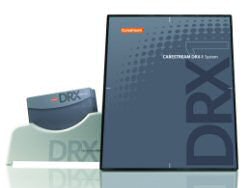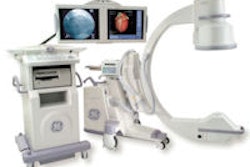
Medical imaging vendor Carestream Health today launched a new wireless digital radiography (DR) panel that's designed to fit into existing analog radiography systems without the need for any retrofit adaptations.
 |
| Carestream's DRX-1 panel fits into existing radiography buckys. |
DRX-1 is a flat-panel detector that slips into a conventional 14 x 17-inch (35 x 43-cm) cassette bucky. Its wireless capability enables it to transmit images to a PACS network without the use of cables, Minnigh said.
DRX-1's design means that imaging facilities won't have to retrofit their equipment to go digital -- they can simply remove their old film buckys and insert a DRX-1 panel. "You don't have to retrofit the room," Minnigh said. "It just fits."
Riding the trend
DRX-1's introduction comes at a fortuitous time for Carestream. After years of resistance to DR due to its high cost, imaging facilities have been adopting the technology at a growing pace. A 2006 report by market research firm IMV Medical Information Division of Des Plaines, IL, found that DR sales matched those of analog radiography for the first time starting in 2005.
Reasons for the shift include DR's workflow benefits over film and CR, and the need for sites to move radiography images into PACS networks. This trend will only gain steam in the future, Minnigh believes, as an aging population's need for more imaging services is balanced against the increasingly limited availability of healthcare workers.
Computed radiography also enables facilities to go digital at a low cost, but Carestream believes that DRX-1 will offer more productivity benefits. Unlike with CR, radiologic technologists won't need to remove the cassette and transport images to a reader -- the images will be transmitted wirelessly.
DRX-1 panels can be used in radiography systems based on bucky, wall stand, or tabletop configurations. Images are produced in less than five seconds and can be previewed at a technologist quality control (QC) console with a touchscreen monitor. One console can support three DRX-1 detectors, Minnigh said.
The DRX-1 detector itself weighs 8.5 lb and is based on a gadolinium oxysulfide (GOS) scintillation material, with a 139-micron pixel pitch. It supports up to 200 lb of weight and has been drop-tested to survive a fall from a height of 3 feet.
The panel holds a charge for about three hours, at which point its battery can be removed and recharged using a toaster-shaped charger. Carestream estimates that a typical DRX-1 battery will retain 90 images, and a busy facility might need to recharge the battery twice a day. Most facilities will probably have several batteries for each DRX-1 panel to ensure that they can use the panel continuously, Minnigh said.
If a DRX-1 detector goes down or needs to be serviced, facilities can simply revert to film- or CR-based operation, keeping the x-ray room productive.
"Many DR retrofits require you to take out the bucky and replace it with a DR bucky or an oversized bucky," Minnigh said. "If a DRX-1 panel goes down, the whole room doesn't go down."
Carestream will begin taking price quotes for the system in October, with the panel carrying a list price of $125,000. This compares to a list price for DR ranging from $250,000 to $660,000, according to Minnigh.
Carestream will demonstrate DRX-1 for the first time at the Journées Françaises de Radiologie (JFR) meeting in Paris, October 24-28, and shipments are scheduled to begin in March 2009.
Carestream believes that DRX-1 will find favor at many facilities that have recently purchased analog x-ray equipment and would like to go digital, but don't want to throw out their investment. Facilities with aging equipment that needs to be replaced should probably just buy a full DR suite, and Carestream will continue to offer integrated DR products, according to Minnigh.
"There are advantages in a fully integrated room," he said. "But for getting existing rooms as close as possible to DR workflow, this does the trick."
By Brian Casey
AuntMinnie.com staff writer
September 2, 2008
Related Reading
DelliSanti to head Carestream Molecular unit, August 29, 2008
Carestream to provide imaging technology to Olympics, July 29, 2008
Carestream rolls out PACS upgrade, July 24, 2008
Carestream debuts RIS mammo module in Denmark, July 15, 2008
Carestream gets Health Canada nod for CR mammo, July 9, 2008
Copyright © 2008 AuntMinnie.com



















